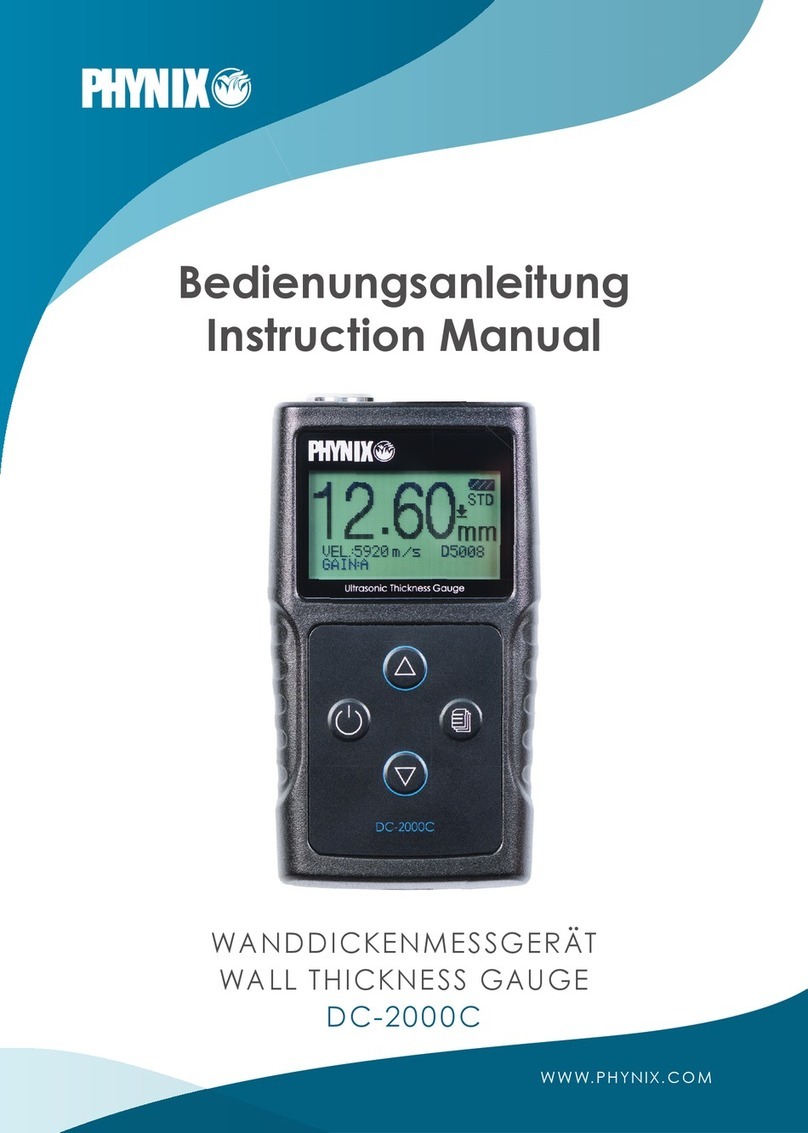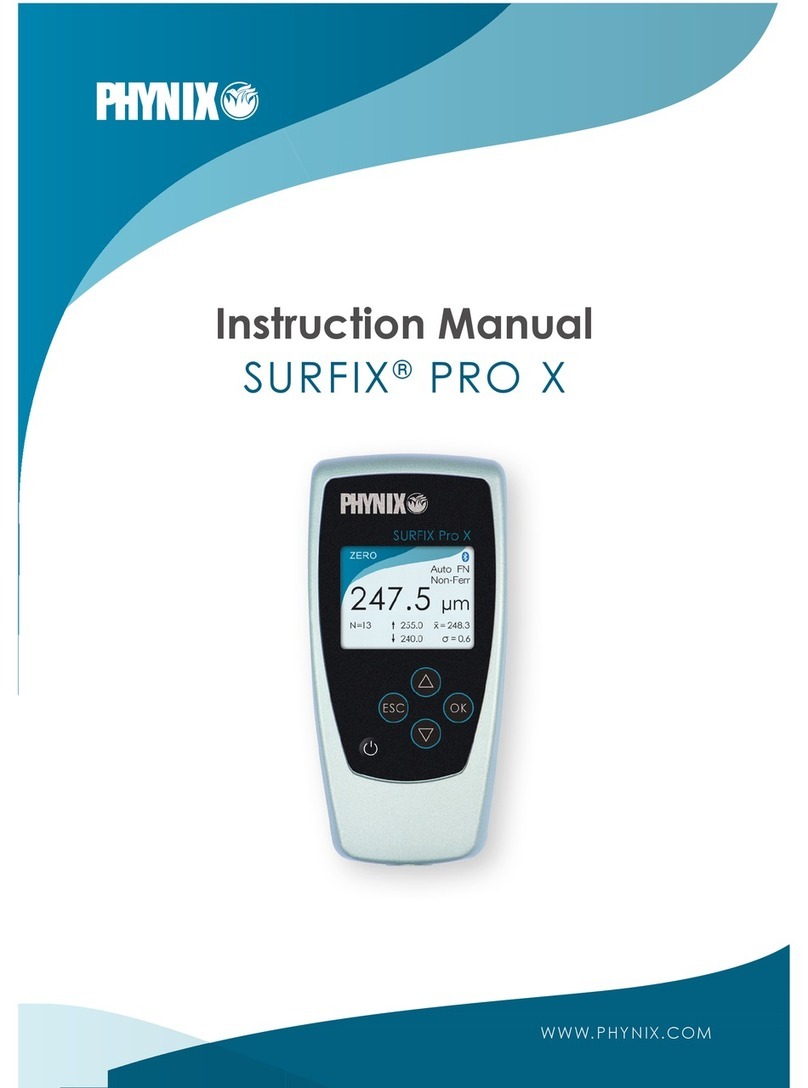b) you'll complete a setting action, e. g.
measuring unit µm, or you'll confirm
the set calibration or limit values.
Key
This key enables you to
a) return to the next higher menu level up
to start screen (- - - -)
b) delete the last reading immediately after
the measurement
c) interrupt a setting action e.g. when
setting calibration and limit values (n.b.).
Infrared interface (n.b.)
For the infrared data transmission from
Pocket-Surfix®to a printer or to a PC, the
following three requirements must be met:
1. The infrared adapter (accessory part)
must be connected to the printer or PC.
The infrared window of the gauge and of
the adapter must be parallel and face
each other at a distance of
approximately 30cm to 50cm / 12” to
20” for the data transmission.
©PHYNIX Germany
On delivery, or after a total reset, the first
menu item of each optional menu item is
always set (e.g.µm/mils).
Selecting metric system (µm) or inch
(mils) as unit of measurement
Procedure:(please also see menu structure)
1. Press until Options appears
2. Press; µm unit appears
3. Press and confirm µm unit of
measurement with it or
4. Press until mils unit of
measurement appears
5. Press and confirm mils unit
of measurement with it
6. Press. Unit of measurement
µm or mils selected will
briefly appear, and then the
start screen with the four
dashes - - - - .
©PHYNIX Germany
General information about IR-Adapter you
will find an page 25.
2. The serial interface parameters of the
PC and the printer must be set as
follows:
- Baud rate: 9600
- Data bits: 8
- Stop bit: 1
- Parity: none
- Handshake non
3. A data transmission program must be
installed for the data transmission to a
PC (See page 25).
Error display
Faults or malfunctions identified by the
instrument are indicated by an error
message:
Batteries are empty:
Please insert new batteries. Please pay
attention to the correct polarity. Please
exchange the batteries within 20 seconds in
order to keep the saved data.
- 20 -
You can carry out the settings below
according to the same procedure.
• Setting of measuring mode FN, F or N
• Setting of switch-off mode, Auto switch-
off or Permanent operation
• Setting of display backlight OFF (n.b.)or 3
seconds of backlight or Permanent
backlight (n.b.)
• Setting of Beeper ON or OFF (n.b.)
• Setting of online statistics N,
, s or N,
Max, Min (n.b.)
• Setting of Welcome text ON or OFF
• Setting of Power supply, Batteries or
Rechargeable batteries
• Selection of Language German or
English or French or optional language
Total Reset
This setting causes
a) the deletion of all single values and of the
statistical values
b) the deletion of the set calibration values
and the resetting to the works-calibration
- 18 -
Calibration an measurement
(1st Main menu item)
Pocket-Surfix®is works-calibrated. If a more
accurate measurement is desired, the
instrument can be calibrated as described
below.
Thanks to calibration using the uncoated
test object, measuring errors especially due
to the surface geometry of the test object
are excluded, e.g. plane or curved surfaces.
You do not have to repeat a calibration
process that you have once carried out after
switching the instrument off and on again if
you want to measure on test objects of the
same kind.
NOTE: If needed, you can also calibrate
using the Fe or Al zero calibration standards
included in the supply, provided that the
surfaces to be measured are plane and
larger than 35mm x 35mm / 1.4” x 1.4”.
Depending on the application, you can use
three different calibration modes with
Pocket-Surfix®:
©PHYNIX Germany
8. Press; Calibration has been
set appears briefly, and then
the start screen with the four
dashes - - - - .
You can now carry out the measurement.
Zero Offset Setting (n.b.)
In this menu item, a constant positive or
negative value can be set. This value is then
automatically added to the measured value
or subtracted from the measured value
every time a measurement is carried out.
The display then shows the addition or the
difference. Moreover, the zero offset setting
is always indicated below in the display as a
reminder.
This measuring mode is useful when
determining the upper coating layer of a
multi-layer system. If the lower layer(s) is
(are) known and show an adequately uniform
thickness, the coating thickness of this
(these) layer(s) can be set as a negative
offset value. The display then only shows the
thickness of the top layer.
©PHYNIX Germany
Preset works calibration
For measurements on plane surfaces which
are larger than 35mm x 35 mm / 1.4” x
1.4”.
The previous calibration(s) is (are) deleted.
You'll need neither a calibration standard
nor an uncoated measurement object.
Procedure:(please also see menu structure)
1. Press; Calibration appears
2. Press; Zero setting appears
3. Press; repeatedly until Delete
calibration appears
4. Press; Works calibration
activated and then the start
screen with the four dashes
- - - - .
You can now carry out the measurement.
- 9 -
When measuring coated rough metal
surfaces, this mode can also be selected. In
this case, the roughness effect, which is
determined on the basis of the uncoated
rough metal surface, is set as a negative
offset value. The instrument will then display
the coating thickness above the peaks of the
rough surface.
Procedure:(please also see menu structure)
1. Press; Calibration appears
on the display
2. Press; Zero Setting appears
on the display
3. Press twice; Zero Offset
appears on the display
4. Press; Offsets appears on
the display
5. Press; Set Offset Value
appears on the display
6. Press; until the required
offset value appears on the
display
- 11 -
ESC
MENU
OK
MENU
OK
OK
MENU
OK MENU
OK OK
MENUMENU
OK OK
OK OK
MENU






























